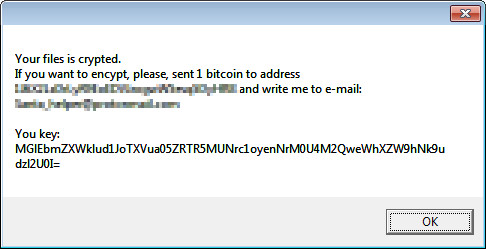RANSOM_OZOZALOCKER.A
Windows


Threat Type: Trojan
Destructiveness: No
Encrypted: No
In the wild: Yes
OVERVIEW
This Trojan arrives on a system as a file dropped by other malware or as a file downloaded unknowingly by users when visiting malicious sites.
It connects to certain websites to send and receive information. It is capable of encrypting files in the affected system.
TECHNICAL DETAILS
11,264 bytes
EXE
Yes
24 Nov 2016
Arrival Details
This Trojan arrives on a system as a file dropped by other malware or as a file downloaded unknowingly by users when visiting malicious sites.
Installation
This Trojan leaves text files that serve as ransom notes containing the following:
- Files has been encrypted. If you want to decrypt, please, send 1 bitcoin to address 1J6X2LzDrLyR9EoEDVJzogwW5esq5DyHRB and write me to e-mail: Santa_helper@protonmail.com You key: {generated key}
Other System Modifications
This Trojan adds the following registry keys:
HKEY_LOCAL_MACHINE\SOFTWARE\Classes\
.locked
HKEY_LOCAL_MACHINE\SOFTWARE\Classes\
OzozaLocker\shell\open\
command
It adds the following registry entries:
HKEY_LOCAL_MACHINE\SOFTWARE\Classes\
.locked
@ = "OzozaLocker"
HKEY_LOCAL_MACHINE\SOFTWARE\Classes\
OzozaLocker\shell\open\
command
@ = "wscript \"C:\Windows\message.vbs\"
Dropping Routine
This Trojan drops the following files:
- %Desktop%\HOW TO DECRYPT YOU FILES.txt
- %Windows%\message.vbs
(Note: %Desktop% is the desktop folder, where it usually is C:\Documents and Settings\{user name}\Desktop in Windows 2000, Windows Server 2003, and Windows XP (32- and 64-bit); C:\Users\{user name}\Desktop in Windows Vista (32- and 64-bit), Windows 7 (32- and 64-bit), Windows 8 (32- and 64-bit), Windows 8.1 (32- and 64-bit), Windows Server 2008, and Windows Server 2012.. %Windows% is the Windows folder, where it usually is C:\Windows on all Windows operating system versions.)
Other Details
This Trojan connects to the following website to send and receive information:
- http://{BLOCKED}.{BLOCKED}.107.186/receiver.php?key={generated key}&value={generated password}
It encrypts files with the following extensions:
- {Original Filename}.locked
It does the following:
- Exclude the files with the following extensions from encrypting:
- .exe
- .dll
- .locked
- Exclude the files in the following folders from encrypting:
- %Application Data%
- %Windows%
(Note: %Windows% is the Windows folder, where it usually is C:\Windows on all Windows operating system versions.)
It is capable of encrypting files in the affected system.
NOTES:
Displays the following message box as ransom note:

SOLUTION
9.800
12.918.03
24 Nov 2016
Step 1
Before doing any scans, Windows XP, Windows Vista, and Windows 7 users must disable System Restore to allow full scanning of their computers.
Step 2
Note that not all files, folders, and registry keys and entries are installed on your computer during this malware's/spyware's/grayware's execution. This may be due to incomplete installation or other operating system conditions. If you do not find the same files/folders/registry information, please proceed to the next step.
Step 3
Identify and terminate files detected as RANSOM_OZOZALOCKER.A
- Windows Task Manager may not display all running processes. In this case, please use a third-party process viewer, preferably Process Explorer, to terminate the malware/grayware/spyware file. You may download the said tool here.
- If the detected file is displayed in either Windows Task Manager or Process Explorer but you cannot delete it, restart your computer in safe mode. To do this, refer to this link for the complete steps.
- If the detected file is not displayed in either Windows Task Manager or Process Explorer, continue doing the next steps.
Step 4
Delete this registry key
Important: Editing the Windows Registry incorrectly can lead to irreversible system malfunction. Please do this step only if you know how or you can ask assistance from your system administrator. Else, check this Microsoft article first before modifying your computer's registry.
- In HKEY_LOCAL_MACHINE\SOFTWARE\Classes
- .locked
- .locked
- In HKEY_LOCAL_MACHINE\SOFTWARE\Classes
- OzozaLocker
- OzozaLocker
Step 5
Search and delete this file
- %Windows%\message.vbs
- %Desktop%\HOW TO DECRYPT YOU FILES.txt
Step 6
Scan your computer with your Trend Micro product to delete files detected as RANSOM_OZOZALOCKER.A. If the detected files have already been cleaned, deleted, or quarantined by your Trend Micro product, no further step is required. You may opt to simply delete the quarantined files. Please check this Knowledge Base page for more information.
Did this description help? Tell us how we did.

